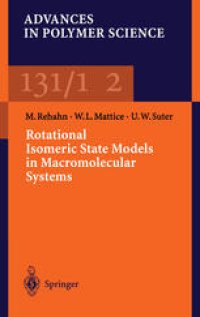
Ebook: Rotational Isomeric State Models in Macromolecular Systems
- Tags: Polymer Sciences, Condensed Matter Physics, Physical Chemistry, Theoretical and Computational Chemistry
- Series: Advances in Polymer Science 131/132
- Year: 1997
- Publisher: Springer-Verlag Berlin Heidelberg
- Edition: 1
- Language: English
- pdf
Over the past 40 years, Rotational Isomeric State (RIS) models for hundreds of polymer structures have been developed. The RIS approach is now available in several software packages. The user is often faced with the time-consuming task of finding appropriate RIS parameters from the literature. This book aims at easing this step by providing a comprehensive overview of the models available. It reviews the literature from the first applications of RIS models to the end of 1994, comprises synthetic as well as naturally orccuring macromolecules, and tabulates all the pertinent features of published models. It will help readers, even when not very familiar with the method, to take advantage of this computationally efficient way of assessing the conformational properties of macromolecular systems.
Over the past 40 years, Rotational Isomeric State (RIS) models for hundreds of polymer structures have been developed. The RIS approach is now available in several software packages. The user is often faced with the time-consuming task of finding appropriate RIS parameters from the literature. This book aims at easing this step by providing a comprehensive overview of the models available. It reviews the literature from the first applications of RIS models to the end of 1994, comprises synthetic as well as naturally orccuring macromolecules, and tabulates all the pertinent features of published models. It will help readers, even when not very familiar with the method, to take advantage of this computationally efficient way of assessing the conformational properties of macromolecular systems.
Over the past 40 years, Rotational Isomeric State (RIS) models for hundreds of polymer structures have been developed. The RIS approach is now available in several software packages. The user is often faced with the time-consuming task of finding appropriate RIS parameters from the literature. This book aims at easing this step by providing a comprehensive overview of the models available. It reviews the literature from the first applications of RIS models to the end of 1994, comprises synthetic as well as naturally orccuring macromolecules, and tabulates all the pertinent features of published models. It will help readers, even when not very familiar with the method, to take advantage of this computationally efficient way of assessing the conformational properties of macromolecular systems.
Content:
Front Matter....Pages -
Motivation....Pages 1-2
The rotational isomeric state method....Pages 2-4
Publications on fundamental aspects of RIS theory....Pages 5-5
Notation used and structure of the collection of RIS models....Pages 5-6
Index of compounds....Pages 7-18
Collection of RIS models....Pages 19-476
Over the past 40 years, Rotational Isomeric State (RIS) models for hundreds of polymer structures have been developed. The RIS approach is now available in several software packages. The user is often faced with the time-consuming task of finding appropriate RIS parameters from the literature. This book aims at easing this step by providing a comprehensive overview of the models available. It reviews the literature from the first applications of RIS models to the end of 1994, comprises synthetic as well as naturally orccuring macromolecules, and tabulates all the pertinent features of published models. It will help readers, even when not very familiar with the method, to take advantage of this computationally efficient way of assessing the conformational properties of macromolecular systems.
Content:
Front Matter....Pages -
Motivation....Pages 1-2
The rotational isomeric state method....Pages 2-4
Publications on fundamental aspects of RIS theory....Pages 5-5
Notation used and structure of the collection of RIS models....Pages 5-6
Index of compounds....Pages 7-18
Collection of RIS models....Pages 19-476
....